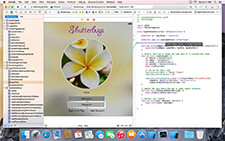IDE
IDE stands for both "Integrated Device Electronics" and "Integrated Development Environment." The first is a hardware term, while the second is related to software programming.
1. Integrated Device Electronics
IDE was the most widely-used type of hard drive from the mid 1990s to the late 2000s. The "integrated" aspect of the name describes how the controller is integrated into the drive itself. IDE and ATA are often used synonymously since they both refer to the same type of hard drive. However, ATA describes the interface while IDE describes the actual hard drive.
The first IDE standard (ATA-1) was released in 1994 and supported data transfer rates of 8.3 Mbps in DMA mode. Enhanced IDE (ATA-2) was standardized in 1996 and supported data transfer rates up to 16.7 Mbps – twice the rate of the original standard. The next several IDE standards were labeled using ATA versions (up to ATA-7), maxing out at 133 Mbps. The IDE interface was eventually superseded by SATA, an even faster interface.
2. Integrated Development Environment
A software IDE is an application that developers use to create computer programs. In this case, "integrated" refers to the way multiple development tools are combined into a single program. For example, a typical IDE includes a source code editor, debugger, and compiler. Most IDEs also provide a project interface that allows programmers to keep track of all files related to a project. Many support version control as well.
Some IDEs provide a runtime environment (RTE) for testing software programs. When a program is run within the RTE, the developer can track each event that takes place within the application being tested. This can be useful for finding and fixing bugs and locating the source of memory leaks. Because IDEs provide a centralized user interface for writing code and testing programs, a programmer can make a quick change, recompile the program, and run the program again. Programming is still hard work, but IDE software helps streamline the development process.
 Test Your Knowledge
Test Your Knowledge
